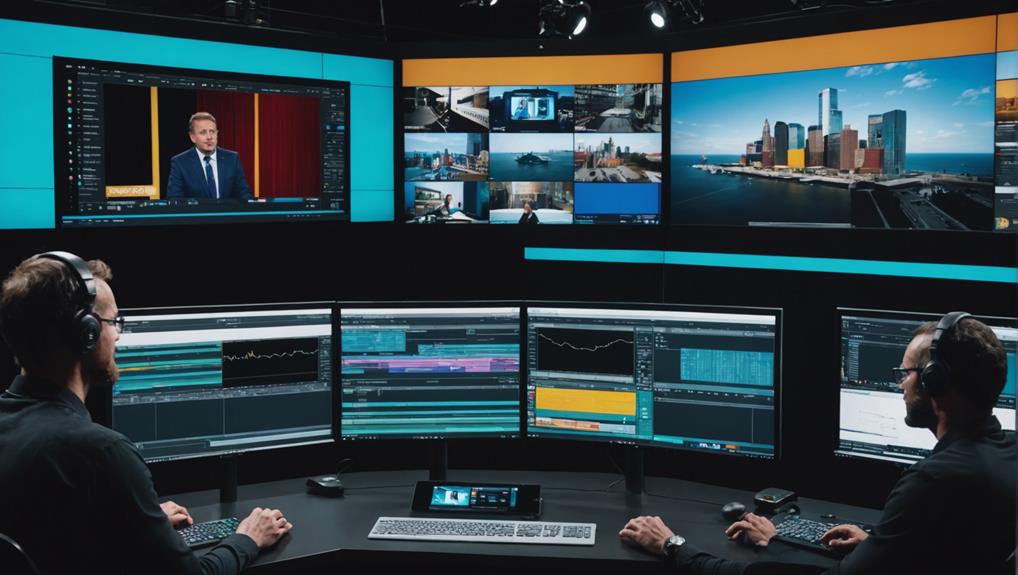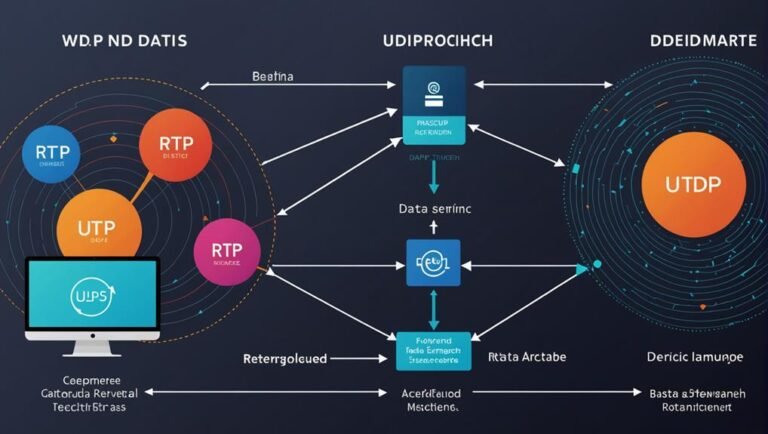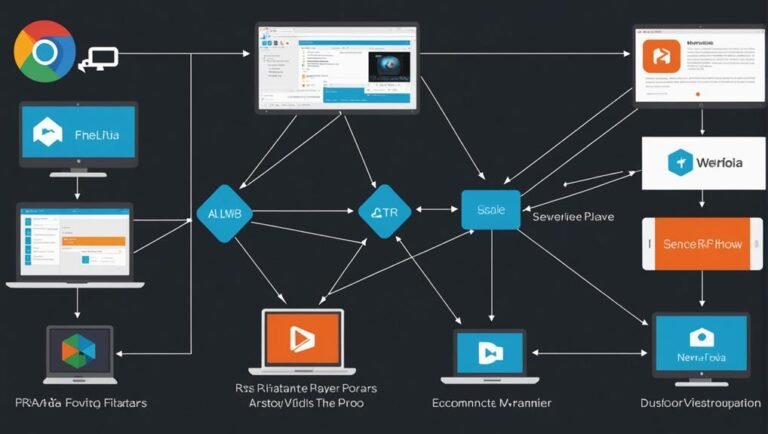When you’re deciding between RTP and RTMP for streaming, know that each has its strengths. RTP is great for real-time communication and can adapt well to various network conditions, but it might require more bandwidth for high-quality streams. On the other hand, RTMP offers low latency, making it ideal for live events and interactive sessions, plus it has robust security features. Your choice should depend on your specific needs, like the importance of latency versus security. If you want to explore their unique applications and performance differences, there’s more to uncover.
Overview of RTP
When it comes to streaming media, a solid understanding of the Real-time Transport Protocol (RTP) is fundamental. RTP offers several advantages, making it a preferred choice for real-time applications like video conferencing and live streaming. One of its key strengths is RTP’s scalability; it can efficiently handle large numbers of users while maintaining quality. However, you should also be aware of the challenges that come with RTP, such as the need for proper security measures and monitoring.
RTP’s packetization process is vital for transporting multimedia content. It allows for the segmentation of data into manageable packets, ensuring smooth playback. Still, without proper RTP monitoring, it can be tough to diagnose issues in transmission. Unlike other protocols, RTP doesn’t guarantee delivery, which means you might face challenges in maintaining quality across various network conditions.
When considering RTP applications, think about how it integrates with other protocols to enhance your streaming experience. Its compatibility with various codecs and formats makes it a versatile choice for developers. However, you’ll need to focus on RTP security, especially when deploying it in environments where data integrity is paramount.
Overview of RTMP
RTMP, or Real-Time Messaging Protocol, is a widely used protocol for streaming audio, video, and data over the internet. It’s particularly favored for its low latency, which is critical for real-time applications like live streaming. You’ll find RTMP deployed in various scenarios, including online gaming, webinars, and live broadcasts, where immediate interaction and feedback are necessary.
One of the significant advantages of RTMP is its compatibility with a range of devices and platforms. Whether you’re using a professional broadcasting suite or a simple webcam, RTMP can support your needs, making it versatile for content creators. However, it’s not just about compatibility; RTMP security also plays an important role. With options for encryption, you can guarantee that your streams are protected from unauthorized access, which is fundamental in today’s digital landscape.
While RTMP latency is generally low, it’s not immune to delays, especially when network conditions fluctuate. Still, it often outperforms other protocols in this regard, making it a go-to choice for those prioritizing speed. The deployment of RTMP is straightforward, allowing you to set up a streaming server quickly and efficiently.
Key Features of RTP
RTP, or Real-time Transport Protocol, boasts several key features that make it a popular choice for streaming media. One of the standout RTP advantages is its ability to handle real-time data efficiently, which is vital for applications like video conferencing and live streaming. With RTP, you can enjoy low latency, ensuring that your content reaches viewers almost instantaneously.
However, it’s important to recognize RTP challenges, particularly regarding its security. While RTP does offer some built-in mechanisms for data integrity, it may require additional protocols, like SRTP, for robust security. It’s always a good idea to think about RTP security when planning your streaming setup.
In terms of RTP applications, it shines in scenarios where timely delivery is paramount, such as in VoIP and online gaming. Plus, RTP’s compatibility with different transport protocols means you can integrate it into your existing systems without much hassle. When you’re configuring RTP, you’ll find that it’s quite flexible, allowing you to tailor it to meet your specific needs.
Scalability is another key feature, as RTP can easily scale to accommodate a growing number of users without compromising performance. This makes it ideal for dynamic environments. Overall, RTP transport provides a reliable framework for streaming media, giving you the freedom to create engaging, real-time experiences for your audience. Whether you’re streaming live events or holding virtual meetings, RTP’s features can help you achieve your goals effectively.
Key Features of RTMP
When you’re looking at RTMP, it’s essential to understand its key features, especially regarding streaming protocol. You’ll want to contemplate how latency and performance factors impact your streaming experience. These elements play a significant role in determining the effectiveness of RTMP for your needs.
Streaming Protocol Overview
In the world of streaming, RTMP stands out for its ability to deliver high-quality audio and video over the internet. This protocol’s design allows for low-latency communication, making it a popular choice for live streaming events. With RTMP, you can utilize various streaming codecs, giving you the freedom to choose the best format for your content. This flexibility means you can optimize your streams based on your audience’s needs and preferences.
One of the key features of RTMP is its focus on network reliability. It maintains a stable connection even under fluctuating network conditions, which is vital for streamers who want their content to reach viewers without interruption. RTMP’s adaptive bitrate streaming guarantees that your audience enjoys a smooth experience, regardless of their internet speeds.
Moreover, RTMP supports a wide range of media types, allowing you to mix and match different formats seamlessly. This versatility means you can create engaging, dynamic streams that keep your viewers coming back for more. Embracing RTMP gives you the control and quality you need to elevate your streaming experience.
Latency and Performance Factors
One of the standout characteristics of RTMP is its low latency, which is crucial for live streaming scenarios. This means you can engage with your audience in real-time, creating a more dynamic and interactive experience. You won’t want to miss a beat, and RTMP helps guarantee that your content reaches viewers almost instantly.
To maintain this low latency, RTMP employs effective buffering strategies. These strategies minimize delays by carefully managing data packets and confirming they’re delivered promptly. You’ll appreciate how RTMP handles fluctuations in network conditions, keeping your stream smooth and uninterrupted.
Network optimization also plays a significant role in RTMP’s performance. By fine-tuning your network settings, you can enhance the streaming experience even further. This means fewer dropped frames and a more reliable connection, which is crucial when you’re broadcasting live events or gaming sessions.
Use Cases for RTP
When it comes to RTP, you’ll find it plays an essential role in real-time media streaming and video conferencing applications. It’s especially popular for live sports broadcasting, where low latency is key. Understanding these use cases can help you see why RTP is such a valuable technology in today’s digital landscape.
Real-time Media Streaming
RTP’s flexibility makes it a go-to choice for various real-time media streaming applications. It’s designed to adapt to changing network conditions, which means you can experience smooth content delivery even when the bandwidth fluctuates. With its emphasis on error recovery and quality assurance, RTP guarantees that your streaming experience remains uninterrupted and enjoyable.
Here’s a quick overview of its key features:
| Feature | Description | Importance |
|---|---|---|
| Adaptive Streaming | Adjusts to varying network conditions | Provides a consistent user experience |
| Codec Compatibility | Supports multiple codecs for audio and video | Guarantees versatility in content |
| Bandwidth Estimation | Estimates available bandwidth for streaming | Optimizes streaming performance |
As RTP continues on its path of protocol evolution, it remains a solid choice for those who value freedom in their media consumption. Its ability to tackle issues such as latency and packet loss makes it suitable for diverse applications, from live broadcasts to multimedia streaming. Ultimately, RTP empowers you to enjoy your favorite content without compromise.
Video Conferencing Applications
Video conferencing tools rely heavily on robust protocols to guarantee seamless communication between participants, and RTP shines in this arena. With its capacity for real-time data transmission, RTP assures high video quality, essential for an engaging user experience. It efficiently manages bandwidth, adapting to varying network conditions without sacrificing performance.
As you navigate through different video conferencing applications, you’ll appreciate the network reliability RTP provides, allowing conversations to flow uninterrupted. The integration of RTP with various applications enhances functionality, confirming that you can connect across platforms with ease. Security measures are also a priority, as RTP supports encryption, keeping your discussions private and secure.
Scalability options make RTP a versatile choice for both small team meetings and large webinars. Its device compatibility means you can join meetings from various devices without hassle. Furthermore, protocol adoption is widespread, allowing you to engage with a multitude of conferencing tools.
Live Sports Broadcasting
In the domain of live sports broadcasting, the need for real-time data transmission becomes even more pronounced. You want to connect fans to the action, and RTP (Real-time Transport Protocol) is your ally in achieving that goal. With RTP, you can deliver high-quality video streams with minimal delay, guaranteeing your audience stays engaged and doesn’t miss a single play.
Imagine your viewers feeling the thrill of the game as if they were right there in the stadium. By leveraging advanced broadcasting technology, RTP allows you to stream live events seamlessly, enhancing the overall experience. This protocol supports the transmission of not just video, but also audio data, enriching the viewing experience with commentary and crowd sounds that bring the event to life.
Moreover, RTP’s ability to handle packet loss and maintain synchronization makes it ideal for sports broadcasting, where every second counts. So, whether you’re streaming a nail-biting finish or a thrilling overtime, RTP guarantees your audience remains captivated. By embracing this technology, you’re not just broadcasting; you’re creating an immersive experience that resonates with sports fans everywhere.
Use Cases for RTMP
Many industries utilize RTMP for its efficient live streaming capabilities. Whether you’re in entertainment, education, or corporate communications, RTMP offers a reliable way to deliver high-quality video content. Here are some prominent use cases where RTMP shines:
| Industry | RTMP Advantages | RTMP Limitations |
|---|---|---|
| Entertainment | Low latency for real-time engagement | Limited support on mobile devices |
| Education | Interactive sessions with audience participation | Requires stable internet connection |
| Corporate | Seamless integration with video conferencing | Can be complicated to set up |
In the entertainment industry, RTMP allows you to stream live events, such as concerts and gaming tournaments, with minimal delay, which is vital for viewer engagement. In education, platforms can leverage RTMP to host live classes, enabling interaction between instructors and students, creating a richer learning experience. For corporate communications, RTMP facilitates webinars and virtual meetings, providing a professional touch to your presentations.
However, it’s important to recognize some RTMP limitations. Not all mobile devices fully support RTMP, which might restrict your audience’s access. Additionally, a stable internet connection is essential for maintaining quality, and setting up RTMP can be somewhat technical.
Performance Comparison
When comparing RTMP and RTP, it’s crucial to assess their performance characteristics, as these can greatly impact your streaming experience. You want to verify that your chosen protocol meets your needs, especially when it comes to factors like bandwidth efficiency and packet loss.
RTMP, being a protocol designed primarily for live streaming, excels in low latency environments. It’s optimized for real-time data transfer, making it a popular choice for applications like live broadcasts and online gaming. You’ll often find that RTMP maintains a higher level of bandwidth efficiency during these scenarios, allowing for smoother, uninterrupted streaming, even under varying network conditions.
On the other hand, RTP is more versatile and widely used in multimedia streaming, especially for applications where delay isn’t as critical. While RTP can handle packet loss through its built-in mechanisms, it may require more bandwidth under certain conditions, especially when streaming high-quality video. This means you might experience more buffering or degradation in quality if the network isn’t robust enough.
Choosing the Right Protocol
Selecting the right streaming protocol for your needs can greatly enhance your overall experience. When it comes to choosing between RTP and RTMP, consider factors like protocol compatibility, network considerations, and security features. Each protocol has its own strengths and weaknesses, and understanding these nuances can empower you to make the best choice.
Here’s a quick comparison to help you out:
| Feature | RTP | RTMP |
|---|---|---|
| Bandwidth Requirements | Varies (low latency) | Generally higher |
| Application Scenarios | Live streaming, VoIP | Live video, Flash apps |
| Scalability Options | Limited | Highly scalable |
| Security Features | RTP does not encrypt | Supports RTMPS (SSL) |
When you weigh your options, think about your specific application scenarios. Are you aiming for a low-latency experience? RTP might suit you better. But if your focus is on user experience with robust security features, RTMP could be the way to go.
Also, keep in mind the implementation challenges. If your network has specific constraints, those could dictate your choice as well. By evaluating these factors, you’ll be better equipped to select the streaming protocol that meets your needs, ensuring a seamless and enjoyable experience.
Frequently Asked Questions
What Are the Main Differences Between RTP and Rtmp?
When exploring streaming applications, you’ve got to take into account protocol efficiency. RTP, or Real-time Transport Protocol, is designed for real-time streaming, making it great for applications needing low latency. On the other hand, RTMP, or Real-Time Messaging Protocol, excels with reliable connections and is often used for live video streaming. So, while RTP focuses on timely delivery, RTMP guarantees stable communication, giving you flexibility based on your streaming needs.
Can RTP and RTMP Be Used Together?
Yes, RTP and RTMP can be used together in certain integration scenarios. You might find that they complement each other well, allowing for efficient streaming and real-time communication. Protocol interoperability helps you leverage both protocols’ strengths, like RTP’s low-latency capabilities alongside RTMP’s robust streaming features. By combining them, you can create a more versatile streaming solution that gives you the freedom to adapt to various media delivery needs without being limited by a single protocol.
Which Protocol Is More Secure, RTP or Rtmp?
When comparing security, you’ve got to reflect on RTP encryption and RTP authentication, which provide robust measures for protecting data. On the other hand, RTMP vulnerabilities can expose your streams to risks, even with its security protocols in place. If you value freedom and privacy, RTP tends to offer a more secure option for real-time communication. Ultimately, it’s vital to weigh the strengths and weaknesses of both protocols before making a choice.
Are There Licensing Fees Associated With RTP or Rtmp?
When you’re exploring streaming protocols, you might wonder about RTP licensing and RTMP costs. Generally, RTP doesn’t have licensing fees, making it a more flexible choice for those who value freedom. On the other hand, RTMP may involve some costs, particularly if you’re using proprietary software for streaming. It’s crucial to take into account these factors based on your specific needs and whether you want to keep your options open without financial constraints.
How Do RTP and RTMP Handle Network Congestion?
When maneuvering network nuances, you’ll find packet loss and latency management are essential. RTP’s resilient response to congestion keeps data flowing fluidly, adjusting dynamically to disruptions. In contrast, RTMP’s reliance on a steady stream can lead to delays when the network’s overloaded. You’ll appreciate how RTP prioritizes real-time performance, while RTMP offers more structured delivery, which might constrain your creative freedom. Ultimately, understanding these differences equips you to choose wisely for your streaming needs.



